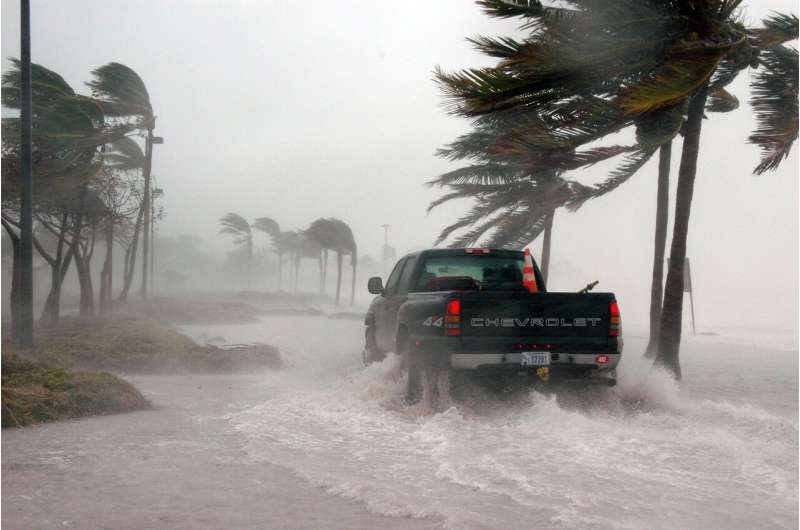This article has been reviewed according to Science X's editorial process and policies. Editors have highlighted the following attributes while ensuring the content's credibility:
fact-checked
trusted source
written by researcher(s)
proofread
It's too hard to make business decisions in the face of climate uncertainty—here's how 'storylines' could help

What will our climate look like in the future? It is hard to overstate not only the importance of answering this question, but also the challenges involved in doing so.
We know the climate is changing rapidly. But without information about where we are headed, planning—at personal, organizational and societal levels—becomes tricky, to put it mildly.
Because climate risks are also understood as financial risks, many countries around the world—including Australia—are moving to make climate risk reporting mandatory. Accordingly, this need for a plan can no longer be ignored.
But the way we currently communicate climate risk has some serious limitations.
Recent research led by Tanya Fiedler explores these limitations, and proposes that a new approach—incorporating the power of narratives—would be more useful and practical for organizations.
We all struggle with uncertainty
Why is painting a picture of our future climate to help us make decisions so difficult? Part of the answer lies in the way individuals make decisions under uncertainty.
People tend to find it difficult to cope with uncertainty and ambiguity, often struggling when presented with probabilities. This can impact our decisions, leading to undesirable outcomes.
Research has also shown we find it difficult to respond to warnings that fall outside our lived experience.
The other part of the answer lies in the inherent complexity—and uncertainties—involved in developing a useful picture of the future.
The most common way to explore our future climate is to use global or regional climate models—complex mathematical simulations of our climate system. These have proven extraordinarily valuable to simulate how our climate will change due to increases in greenhouse gases.
They can project how temperature, rainfall, winds, fire risk and even hail risk are likely to change in future.
But projections are by definition uncertain, and using different models can provide different visions of the future.
The problem with zooming in
This uncertainty tends to increase both as you zoom in to particular locations and become interested in extremes.
For example, how average winter rainfall is expected to change over southwest Western Australia could be relatively clear, but how extreme rainfall (capable of causing major floods) will change is far less clear.
When looking at the level of a postcode or single address, we might not even know whether extreme rainfall will increase or decrease.
That's a problem for organizations trying to work out how to manage and prepare for such risks, often at the scale of an individual building. Modeling is precise, but not necessarily accurate enough for that sort of localized information.
This doesn't mean climate models aren't useful or don't provide valuable information. It just means organizations may need to enhance the value of that information by combining it with other evidence.
Introducing 'storylines'
Fortunately, there is a way to address both the behavioral and modeling issues that capitalizes on how we most intuitively make sense of the world. This is through "storylines."
Storylines were developed in the climate sciences to describe uncertain physical climate futures. They do this by employing expert judgment to prioritize an understanding of the "causal networks" that drive changes and extremes.
The valuable information held in climate model projections is combined with other types of evidence relevant to a location, to develop a plausible (and useful) story about what the future might entail.
Flood risk, for example, depends on a wide range of factors. These can include:
- the amount and intensity of rain
- whether heavy rain fell in the recent past
- changes to the catchment such as vegetation, soils and the nature of any upstream developments, including new roads or buildings.
A business only using changes in rainfall drawn from a climate or national-scale flood model for its risk assessment might "hard-wire" a future scenario that turns out to be unreliable at the scale they need.
Under an alternative "storylines" approach, their best course of action to understand flood risk would be to work with experts to develop a narrative that describes changes in rainfall in addition to all other locally relevant factors.
This narrative can then be tested using traditional flood modeling methods to provide more robust and useful insights into how the local catchment will be impacted under conditions of changing rainfall.
The quantitative disciplines like finance, economics and accounting may struggle with the idea that a narrative might provide more decision-useful information than a number. Yet, research has shown that narratives can make an uncertain future more tangible than numbers, and thereby better aid with planning and decision-making.
We need a new toolkit
Answering the question "what will our future climate look like?" challenges us to think differently and to look for solutions outside the toolbox of established financial tools and techniques.
It challenges us to work—through interdisciplinary dialogue—with experts, disciplines and knowledge we might feel uncomfortable with.
Storylines could transform the way organizations understand and report their exposure to climate risk. This is unlikely to be easy, and we recognize taking quantitative information from a commercial provider may seem simpler. But it is a more honest and rigorous way of planning for the future climate.
Provided by The Conversation
This article is republished from The Conversation under a Creative Commons license. Read the original article.![]()




















